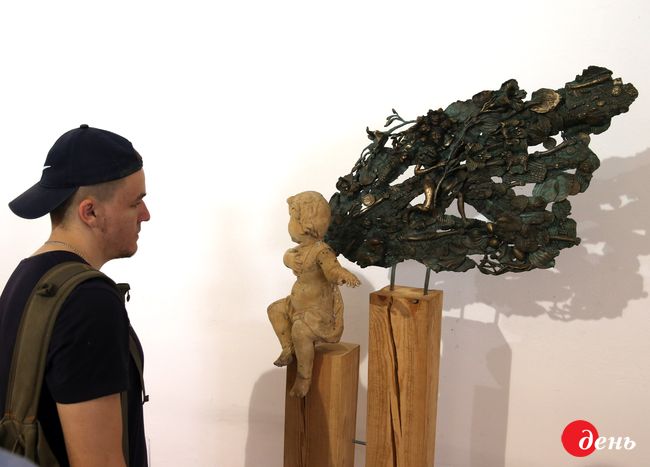The exhibit “Sculpture 2017” includes over 200 works by more than 100 top Ukrainian artists. This Triennial has its own hallmark: the National League of Ukrainian Artists (NLUA)’s total refusal from “politically colored commissioning.”
The name “triennial” indicates at least two purely formal things: a serious scale and the occurrence of the exhibit, only once every three years. However, this time around the NLUA and its exhibition administration are doing well not only in terms of form. Everything is fine with the main thing – the contents, in other words, the quality of the exposition material. Just like another recently held important nationwide “examination” (the big exhibit of Ukrainian abstract painting at the Central House of Artists), this project has attracted best of the best among sculptors. The names of the stars alone take the breath away, send heads reeling, and make hearts miss a beat: Mykola Bilyk, Kostiantyn Synytskyi, Valerii Pyrohov, Alisa Zaboi, Viacheslav Hutyria, Petro Hronskyi, Yehor and Mykyta Zihura, Oleksii Zolotariov, Hanna Kyseliova, to name just a few. If at least one-tenth of the participants agreed to take part in some sort of auction, the clever managers might make a heap of money.

Ukrainian sculptors are quite in demand globally. Quite recently, on June 6, Yehor Zihura alone sold another authorial copy of his Colossus Awakens at Sotheby’s in London at 12,117 dollars. His previous castings of this same sculpture from the project “After Today,” inspired by the Revolution of Dignity, were auctioned for 25,000 dollars at Phillips in London and for 20,000 dollars in New York.

Nevertheless, this Triennial is held for art’s sake in the first place. That is why one can enjoy the works of our top-notch sculptors absolutely for free. The sculptures self are also exhibited not for the sake of money.

By exhibiting own works and seeing those of their colleagues, sculptors also demonstrate their moral support to the House of Artists which is having a hard time now (actually, just like all other Ukrainian artists’ associations). The Triennial agenda includes also master classes by the older generation of sculptors, which will be held at universities.

Of course, it is not only the star-spangled participant list, and not only their numbers that inspire. The variety and quality of the displayed works are inspiring as well. Surprisingly, the exposition contains minimum minimorum of kitschy interior sculptures and other pretty-looking junk. On the other hand, one will hardly see the morally obsolete sculptural compositions, reminiscent of the Soviet 1970s. But the most unusual, totally incredible fact is that the House of Artists seems to have gotten rid of the NLUA’s notorious “birthmark”: ideological and political conjuncture. Not so long ago, depending on who headed the nation’s executive power, the exhibits varied from Trypillian themes to mounted Hetmans to guilt crosses, icons, heroes of the war of 1941-45 and so on. Now instead of all that glamour and glitter and kitschy interior items one feels as if in a nice sculpture salon somewhere in Old Europe. The political conjuncture is ousted by artistic conjuncture.

Modern Western sculpture has long departed from the traditional busts or riders on prancing horses, and is even farther from the garden gnomes decorating our very own lawns. The most unbelievable installations, created in most surprising techniques, are called sculptures. The main thing here is the idea, the free flight of imagination. The main thing is to reach out to the viewer and make him remember what they saw. In Ukrainian sculpture, however, innovation is still combined with tradition. It is actually quite good. In one and the same exposition space very different works co-exist in harmony and complement each other. Imagine the wooden Danae with its fantastic plasticity by a living classic Borys Dovhan, which seems to be a breathing, living intertwining of light rays. And next to it, Oleksii Zolotariov’s Birds. The young sculptor’s creation of wood and black metal suggests Kazimir Malevich. Birds were inspired by a little airplane, scratched by someone on a wooden board. The original board is part of the installation.
Old and innovative Ukrainian style: this is a conceptual composition For Two by Vasyl Tatarskyi, where two chairs are actually drinking chums, just as a rusty merry-go-round on a playground. For us, the composition still looks unusual. For the West it is rather a novel on tradition in the 20th century sculpture.
Fantasy and everyday reality, seasoned with excellent sense of humor, are combined in works by Hanna Kyseliova. Visitors of the Triennial can admire her smiling young girl, Walking Barefoot on the Planet, holding her sandals in her hands.
Triennial “Sculpture 2017” includes flying sculptures and sculptures lying on the floor. Some speak to the viewers with the help of little bells. Others are stuck in yellowish glass like bugs in amber. Wood, stone, metal, plastic, paint, living plants in all imaginable (and not quite so) combinations. This exhibit is an absolute must-see. The more so that even some of its drawbacks (unfortunately, trite ideas are quite a few) turn into advantages. Against the unimpressive background the most original works stand out better. Just as it should be.







